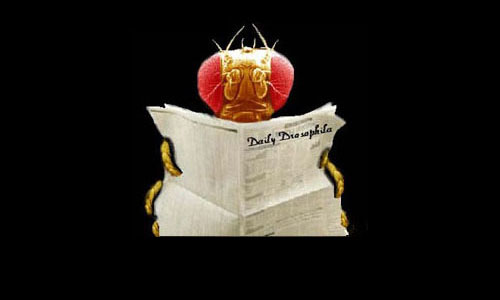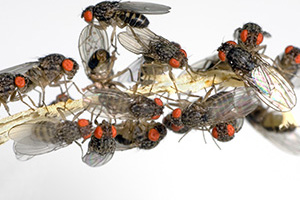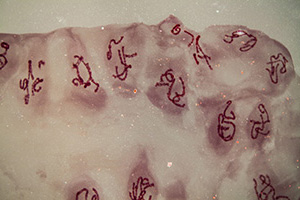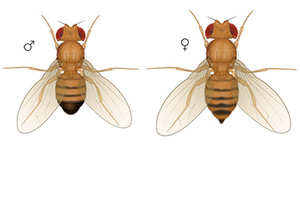Let’s Raise our Glasses to the Fruit Fly Salute!
By Bill Willis and Melissa Wells
September 27, 2018

- Thomas Hunt Morgan is The Fruit Fly Scientist and Daddy Fly
- Drosophila melanogaster is the scientific name for the fruit fly
- The fly has four chromosomes with 14,000 genes
- The fly's genes represent 75% of the genes that cause human diseases
- Six Nobel Prizes have been awarded to fly researchers
Was it from “out of the blue” or a case of spontaneous generation that one fruit fly turned into hundreds? Is this one of those instances where you see one, but know that there must be hundreds that you don’t see? We learned that insects and spiders can take the Highway in the Sky to move from spot to spot. Is this what’s happening, an aerial invasion? Alfred Hitchcock, where are you hiding?
What Are These Flies?

The fruit fly, or vinegar fly, is known in the scientific community as Drosophila melanogaster. NIEHS has a Drosophila research laboratory under the direction of Melissa Wells in F module where they study Post-Transcriptional Gene Expression.
What Good Do They Serve?
Drosophila play, and have played, a significant role in our understanding of genetics and disease. With a life span that can be regulated by food and temperature, the complete life cycle can be as short as weeks. Over the course of a year, scientists can obtain multiple generations with high numbers of replications within a relatively small dedicated space. These flies live fast and breed even faster.
Are There Other Values for Genetic Studies?

The fly’s four pairs of chromosomes have 14,000 genes that provide much genetic diversity. The chromosomes have light and dark bands that aid in breeding studies. These flies can get many of the same diseases as humans, so they serve as good disease models. Preliminary drug testing to evaluate biochemical pathways is also a role they play.
Why Do Fruit Flies Appear?
The smell of fermentation draws adults. The females lay eggs and the larvae feed primarily on the yeast during the fermentation process. More flies will emerge within a couple of weeks.
How Do You Tell If Your House Guest Is a Real Fruit Fly?
Check to see if they have these characteristics: their bodies are tan to black, big red eyes, droopy abdomens, hover close by, have an attraction to beer, and continually eat sugary treats.
What Is The Difference Between Male and Female Fruit Flies?

Males have dark, rounded genitalia at the tip of their abdomen, whereas females have light, pointed genitalia.
Are Fruit Flies Social Insects?
Laboratory studies have shown that fruit flies know their beers and are considered connoisseurs. By watching what they prefer, you can usually make a good choice. Fruit flies make good drinking friends if you like the more “fruity” brews. Laboratory flies can get intoxicated and exhibit alcohol addiction. They succumb by falling into their brews.
How Can Fruit Flies Be Controlled?
Sanitation. Besides eating fruit before it ferments and keeping beer out of sight, the next best thing might be, to provide the latest flypaper and hope that it holds more than just their attention.
Appreciation is extended to all organisms that made this article possible. Were it not for you, we’d know less and have lesser to say.



